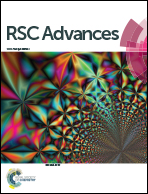Fabrication of cuprous nanoparticles in MIL-101: an efficient adsorbent for the separation of olefin–paraffin mixtures†
Abstract
Various amounts of Cu+ nanoparticles were successfully deposited to the pores of metal–organic frameworks MIL-101 with a double-solvent method. An optimized, cuprous-loaded MIL-101 was shown to have an enhanced ethylene adsorption capacity and higher ethylene–ethane selectivity (14.0), compared to pure MIL-101 (1.6). The great improvement in selectivity can be attributed to the newly generated nano-sized cuprous chloride particles that can selectively interact with the carbon–carbon double bond in ethylene through π-complexation.


 Please wait while we load your content...
Please wait while we load your content...